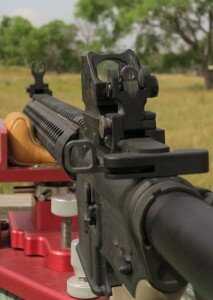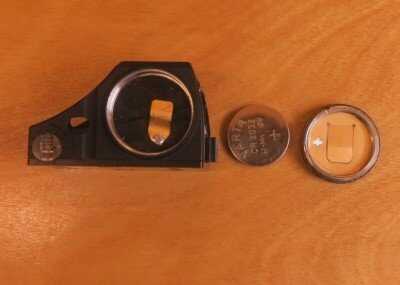By James Darst
Shield CQS
With the ever-growing popularity of the modern sporting rifle platform (I call it a platform because there seem to be an infinite number of configurations), there is a growing trend toward carbines and short barreled rifles (SBR’s). Since these are used for fast, dynamic, short-range work, non-magnified electronic dot sights and backup iron sights work well on these rifles. Smaller and lighter has become the trend, which is good as long as the sights are functional and reliable.
Red dots are great for these compact rifles, as they give the shooter the maximum field of view and, unlike iron sights, enable the shooter to focus on the target instead of the front sight. The added benefit of a red dot sight is that it negates the short sight radius found on carbines without adding any overall length. There have been several advances over the past ten years that allow the almost seamless use of electronic sights with either fixed iron sights or backup/flip up sights. Manufacturers are paying close attention to the mounting height to allow use of either or both at the same time without sacrificing performance of either. Of course, there are negatives associated with most, if not all, of the electronic sights. They need batteries. Most need to be turned on before they can be used which is not always practical to do on some of them when you’re in a hurry. Many sights are large, with somewhat exposed switches and adjustment turrets that may be easily damaged or bumped, causing loss of illumination or zero.
The Shield CQS is an electronic red dot sight with an anodized black aluminum housing (other colors are available) weighing a scant 2.3 ounces. The unit is a reflex, parallax-free red dot sight that comes with a Picatinny mounting system. Being a true Picatinny mount, it is not compatible with Weaver bases, as the recoil lug is cut square. It features high-impact polymer lenses that have a non-colored anti-reflective coating. Multiple reticle styles are also available, including, 4 MOA dot, 8 MOA dot and the tested 1 MOA dot with 65 MOA ring.
The CQS minimizes almost all of the problems with a sight that bridges the gap between the popular holo sights and the mini reflex sights, which Shield sells as the J-Point in the US. The CQS is a medium-sized reflex sight. It uses an eye-safe LED to create a 1 MOA dot with a 65 MOA surrounding ring to help the shooter quickly find the small center dot. The 65 MOA circle also corresponds to a shotgun pattern at 30 yards, as it is approximately 20” in diameter. This is interesting as more and more tactical shotguns are being introduced with optional Picatinny rails installed for optical sights and lasers. The CQS operates on a single CR2032 coin cell battery, which can be bought at most discount and drug stores. The battery is located under the side mounted battery compartment, so replacement will not disturb zero. The sight is constantly on and uses a light-sensing automatic intensity adjustment, so when the protective cover is installed, it goes to the minimum setting. Shield claims the battery will last for one year under normal usage.
The first thing I noticed about the CQS is that it has a rear lens, unlike the mini reflex sights. This is a great advantage over the mini reflex sights because the CQS will work in the rain. I have used a mini reflex for years on my 3-gun open division shotgun, and when it rains it’s almost useless. Water can accumulate between the LED and the lens, dispersing the dot into multiple small dots scattered across the field of view.
The CQS has slotted screws for windage and elevation that are wide enough to be adjusted with a coin or a screwdriver. This is an improvement on many of the sights of this style that would require the use of a hex wrench, usually a metric one that is difficult to find when needed. The body is marked with 2 MOA graduations and does not click at each one. This allows for an infinite adjustment, as you don’t have to worry about being “in between a click” while zeroing. It also comes with a standard Picatinny mount with a ½” tall spacer that will allow for co-witness mounting with backup iron sights on the AR15 platform. Without the spacer, the height should work for many tactical shotguns. The cover fits snuggly and has a provision to tie it to part of the weapon so it will not be lost when rapidly deployed. This feature allows for a sight to be left on in a low-power mode and instantly turned on to the correct brightness by simply removing the protective cap. Across the front is a slide that can also place the sight in minimum-brightness mode. It can be used with night vision devices or to simply turn the unit into a low-power “off” mode.
I used a 16” AR15 carbine equipped with flip-up backup iron sights. It has a 15” long hand guard to maximize the sight radius. On the range, I spent some time shooting at multiple targets at various ranges from 10 to 100 yards to get a feel for how quickly I could engage targets with just the backup iron sights. As the light began to fade in the evening, it was taking longer and longer to acquire a good sight picture to insure a good hit on the target. When I installed the CQS sight just in front of the rear sight, I was again able to rapidly engage the targets, actually faster than I could with good lighting conditions with just the iron sights.
On a second range visit, I tested the CQS in standalone mode and in conjunction with the backup iron sights. When used as a standalone sight, it proved to be a very quick and easy-to-use system. The illumination is bright enough to be used in noonday sunlight. With the small 1 MOA dot, it proved to be precise enough for MOA to sub MOA groups at 100 yards, provided a small aiming point on the target. With the large 65 MOA ring, close-in targets could be very rapidly engaged with little to no effort, as the large ring acts as a huge dot. The only problem I encountered was that the auto illumination can be fooled if you are in a dark area looking onto a light one, such as could be encountered in a house-clearing scenario. This is where the use of the CQS co-witnessed with back up sights works very well. In areas with low to almost no ambient light, the sight does all the work as irons cannot be seen. On the other hand, when the auto illumination is fooled, you still have the backup irons with plenty of light to see them. It’s a win-win.
[one_half]
[one_half_last]

The CQS can be mounted very close to the iron sights, as there is no need to access the rear for battery, power or zero adjustments.

The compact aluminum housing of the CQS is no wider than the backup iron sights mounted on this AR15.

A sliding cover can be used to place the CQS in in minimum-brightness mode for a low-power “off” stand-by for night vision.
[/one_half_last]













Thats cheap!!! they should be selling like hot cakes
LOL….. that’s another gun to own there buddy….I enjoy your sarcasm!!!! 🙂
US dollar retail price for the CQS (excl tax) is $530 at today’s exchange rate
That there sight is 369 euros so since the dollar is weaker than the euro I would go out on a limb and say its just as much and if not more than the eotech… that sight looks bad ass but I think the eotech has way more options available for this price range… either one would be awesome to own… shooters preference!!!!
Another thing to consider, is that, at 2.3 ounces, this is less than half the weight of even an EOTech XPS3.
Well drthunder another 2.3 ounces is not going to scare me from owning a eotech….besides I’m a 225 pound fit guy so 5 ounces isn’t even going to frighten me into owning this sight… like I said in the comment shooters preference….I’m not bias towards either other than the eotech has seen much more service time over seas than this sight…. this may be the new best thing who knows???? only time can tell!!!!!
Price? Or is it like EOTech–if you have to ask, you can’t afford it?